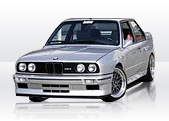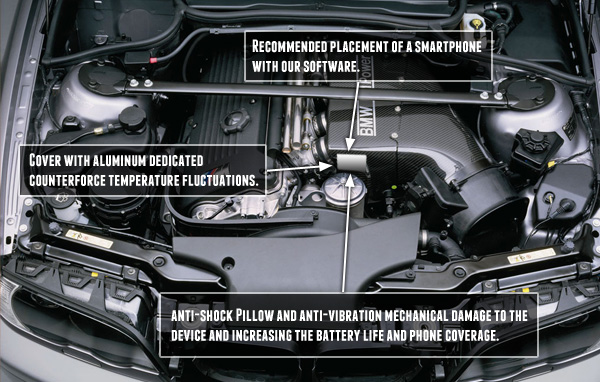
BMW 3 SERIES E30 GPS Tracking
Track your 3 SERIES E30 for free and visualize it on map
Produced to: 1994
How to track your favourite BMW - model 3 SERIES E30 in realtime for free ?
Producer remarks about this particular model
SERIES 3 E30 like the whole series 3 those cars represent middle class motors. It's the most popular series of BMW. Model M3 E30 in less than five years of starts has won over 50 titles and 1,500 individual victories which makes it the most successful GT car in the world.Our product description
We are offering you completely free of charge our GPS car tracking solution in real time. The only thing you need to do is to install smartphone with Android inside your vehicle with our awesome application on board
If you want to track your BMW 3 SERIES E30 in real time you have to do the following :
1. Download Free Car Tracking Application for 3 SERIES E30 application from Google Play
2. Create free account on spysat.eu (for example johndoe) - here is detailed instruction
3. Define Device endpoint for each vehicle you want to track - give friendly name of your 3 SERIES E30 and PIN (some random will be provided - you can change it if you want)
4. Run SpySat mobile application on the smartphone and type there your LOGIN from SpySat (ex. johndoe) and PIN (from point 3.)
5. Install your smartphone inside the car
6. Enjoy watching position of your car at spysat.eu site.
7. Provide stable power supply - spysat app consumes some energy.
Best options to install smartphone inside BMW 3 SERIES E30

Our designers in collaboration with the BMW engineers have developed an optimal system namierzającego unit is placed in the engine. Based on the settings of the various parts of the engine, it was found that the optimal setting of the device software Car Track is have any of 30 cm from the battery.
Enclosure provides protection against mechanical shock and damage caused by temperature changes. A set of anti-vibration sponge thoroughly protect the device.
To permanently mount a smartphone inside a BMW 3 Series E30, follow these steps:1. Choose a suitable mounting bracket for the phone, preferably one that is waterproof and durable. You can find these at your local automotive store or online retailers such as Amazon.
2. Clean the area where you will be installing the mount to ensure there are no bumps or uneven surfaces that could interfere with the connection between the phone and the vehicle.
3. Use a 3M adhesive promoter on the surface of the bracket before attaching it to the car's dashboard, center console, or any other suitable location. Make sure the bracket is securely attached to the vehicle.
4. Connect your smartphone to the mount using an auxiliary cable or Bluetooth. You can use our free app that you can download from our website to set up a permanent direct connection between the phone and the car's battery. This will allow you to use it as a GPS tracker application without any lag time or disconnects.
5. Download and install a GPS tracking app of your choice, such as Google Maps or Waze, on your smartphone. These apps can provide turn-by-turn directions and other useful features that can help enhance your driving experience.
6. For maintenance tips, it's recommended to clean the screen of your phone regularly with a microfiber cloth and avoid exposing it to extreme temperatures or moisture. Store the phone in a dry place when not in use to prevent damage from humidity or condensation.
Remember that this is just a general guide, and you should always consult the owner's manual for specific instructions on how to modify your vehicle as well as any maintenance tips associated with using a GPS tracker app.
Users opinions and questions
Frequently Asked Questions:
Can you explain the differences between the M20 and S14 engines used in the E30 BMW 3 Series, and which one would have better performance potential?
The M20 and S14 engines are both inline-6 engines, but they were developed for different purposes. The M20 engine was a standard engine used in the majority of the BMW E30 models from 1983 to 1991, while the S14 engine was an upgraded version specifically designed for the BMW M3 (E30) and introduced in 1988.The main differences between the two engines are:
- Cylinder head design: The M20 has a single overhead camshaft (SOHC), while the S14 has a double overhead camshaft (DOHC). This means that the S14 can have more valves and a higher redline, which allows for better performance.
- Displacement: The M20 comes in 2.35L and 2.5L versions, while the S14 has a displacement of 2.3L. However, due to the DOHC design and other modifications, the S14 is more powerful than both M20 engines.
- Power output: The standard M20 engine produces around 138-168 hp, while the S14 produces around 215 hp in stock form. There are also tuned versions of the S14 that can produce up to 500 hp.
In terms of performance potential, the S14 engine clearly outperforms the M20 engine due to its design and displacement. It's important to note that both engines have their own merits and are capable of providing enjoyable driving experiences, but if you're looking for better performance potential, then the S14 is the way to go.
As a car salesperson working for BMW, how do the 1987-2004 BMW E30 3 series models compare to newer generation BMW 3 Series models in terms of performance, technology, and design features?
The 1987-2004 BMW E30 3 series models have a unique charm compared to the newer generation BMW 3 Series models. Here is a comparison between the two generations based on performance, technology, and design features:Performance:
The older E30 models were equipped with inline-4 engines that produced around 138 horsepower in the base model. The M3 version had a high-performance S14 engine that generated up to 215 horsepower. In contrast, the newer generation BMW 3 Series models come with a range of engine options, including turbocharged inline-4s and six-cylinder engines that produce significantly more power (up to 473 horsepower in the M3 Competition).
Technology:
The E30 models didn't have many advanced technologies compared to modern cars. They featured a basic analog dashboard, no navigation system, and only had an AM/FM radio for entertainment. The newer BMW 3 Series models are packed with cutting-edge technology such as digital instrument clusters, touchscreen infotainment systems, Apple CarPlay integration, and advanced driver assistance features like adaptive cruise control and lane departure warning.
Design Features:
The E30 models have a timeless and sporty design that appeals to many enthusiasts. They feature traditional BMW styling cues such as the kidney-shaped grille, round headlights, and compact dimensions. The newer BMW 3 Series models have evolved in terms of design, with more aggressive styling and larger dimensions to accommodate modern technologies and safety features.
In summary, while the older E30 3 series models may lack some advanced technology found in newer models, they offer a unique driving experience that many enthusiasts appreciate. The newer BMW 3 Series models have significantly improved performance, technology, and design features, making them more attractive to a wider range of buyers. However, both generations of the BMW 3 Series are highly regarded for their performance, reliability, and driving dynamics.
What are the common issues with the M50B25 engine found in the E30 3 Series, and what preventive maintenance measures can be taken to reduce the likelihood of these problems occurring?
The M50B25 engine is a reliable and powerful unit, but it does have some common issues. Here are some of them and their potential solutions:1. Oil Consumption: This is one of the most common complaints with the M50B25. The problem usually occurs because of worn-out valve seals or piston rings. To prevent this issue, it's crucial to maintain a proper oil change schedule and use high-quality engine oil that is suitable for your vehicle.
2. Camshaft Position Sensor Failure: This can cause the Check Engine light to illuminate, and in severe cases, it may lead to misfires or even engine failure. To avoid this issue, you should have the camshaft position sensor checked regularly during routine maintenance checks. Replacing the sensor as soon as it fails is essential to prevent further damage.
3. Water Pump Failure: The water pump plays a vital role in cooling the engine. When it fails, the engine can overheat and potentially cause severe damage. To prevent this issue, you should replace the water pump at around 100,000 miles or when doing a timing belt replacement (which should be done every 60,000-90,000 miles).
4. Timing Chain Issues: The M50B25 engine uses a timing chain instead of a belt, which can wear out over time and cause misfires or even engine failure. To prevent this issue, you should replace the timing chain, tensioner, and guide rails as part of your regular maintenance schedule.
5. VANOS System Failure: The Variable-valve-timing (VANOS) system is designed to optimize engine performance and fuel efficiency. However, it can fail over time, causing rough idle, reduced power, and poor fuel economy. To avoid this issue, you should have the VANOS solenoid checked regularly during routine maintenance checks, and replace it as soon as it fails.
6. Transmission Problems: Some E30 3 Series cars with the M50B25 engine had problems with their manual transmission, such as grinding gears and difficult shifts. To prevent this issue, you should have your transmission inspected regularly and replace any worn-out components as necessary.
In conclusion, the M50B25 engine is a durable and reliable unit that can last for many miles when properly maintained. By following the recommended maintenance schedule, using high-quality parts and fluids, and addressing issues promptly, you can minimize the likelihood of these common problems occurring.
How do I determine if the BMW 3 Series E30 in our dealership inventory has a timing chain or timing belt, and what is the recommended maintenance schedule for either component?
To determine whether the BMW 3 Series E30 in your dealership inventory has a timing chain or timing belt, you can refer to the vehicle's service manual. The service manual will provide detailed information on the specific model and its components.If the E30 has a timing belt, the recommended maintenance schedule is generally every 6 years or 75,000 miles (120,000 kilometers), whichever comes first. It's important to note that BMW recommends replacing the water pump and tensioner at the same time as the timing belt.
On the other hand, if the E30 has a timing chain, it does not need regular replacement like a timing belt. However, the chain should be inspected regularly during routine maintenance checks, and if it shows signs of wear or damage, it may need to be replaced.
What are the common transmission issues faced by BMW 3 Series E30 and what is the recommended maintenance schedule for their transmission system?
Common transmission issues faced by BMW 3 Series E30 include:1. Leaks from the transmission cooler lines or seal.
2. Shifting problems, such as delayed or hard shifts.
3. Whining or humming noises coming from the transmission.
4. Clunking sounds during shifts.
5. Slippage or loss of power while driving.
6. Overheating of the transmission.
The recommended maintenance schedule for the transmission system of BMW 3 Series E30 includes:
1. Check and refill the automatic transmission fluid at least once a year, preferably with a high-quality, factory-specified fluid like Red Line or Genuine BMW Transmission Fluid.
2. Inspect the transmission cooler lines for any signs of leaks and replace them if necessary.
3. Check and clean the transmission pan and filter regularly to ensure proper operation.
4. Have a professional mechanic inspect the transmission system for any signs of wear or damage during routine maintenance.
5. Address any shifting problems or noises immediately to prevent further damage to the transmission.